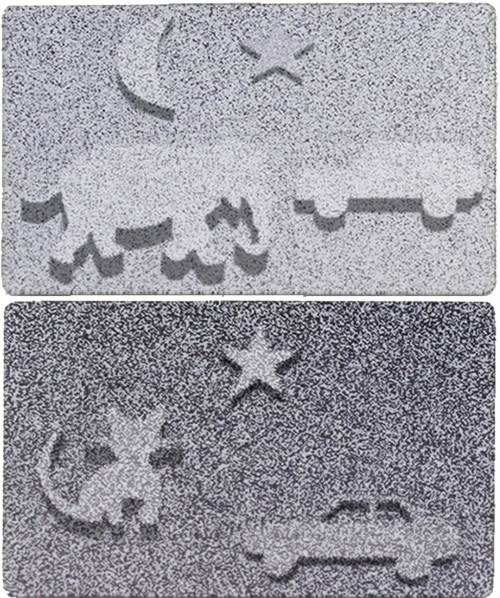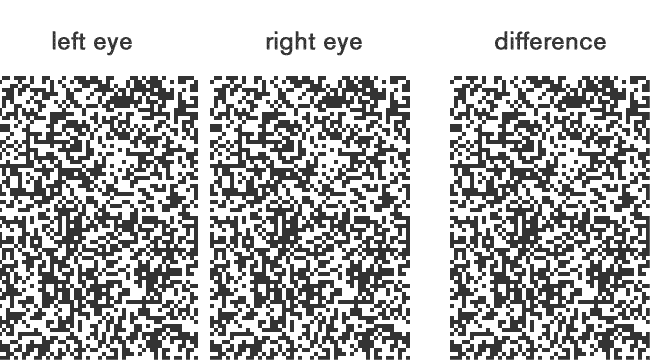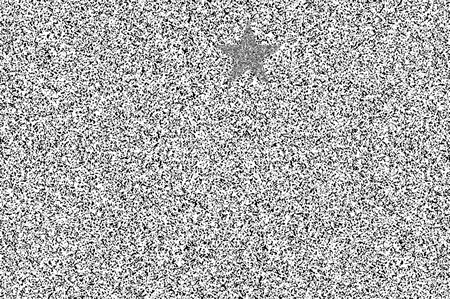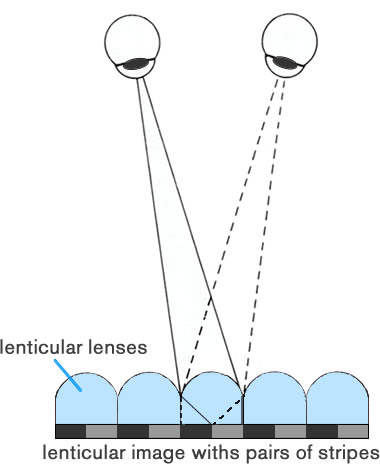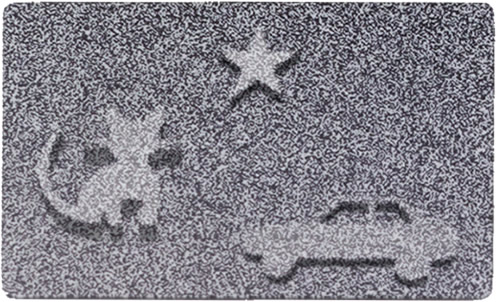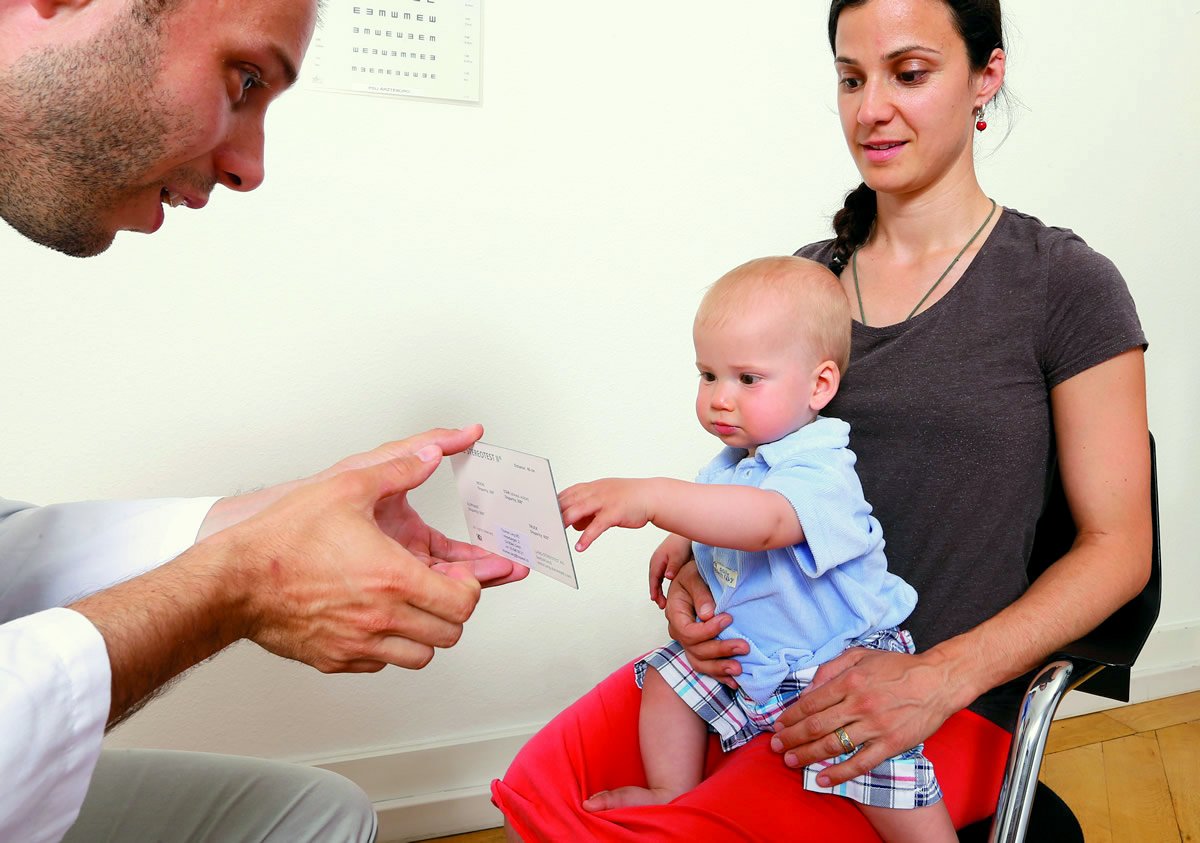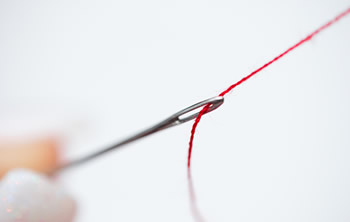The functional principle of Lang-Stereotest explained in brief:
Random dot stereograms are combined with the lenticular method. In the process, silhouettes of the test figures that are slightly shifted sideways are merged with an equally dotted background. The individual images are cut into strips and rearranged in a lenticular image. An applied lenticular film ensures the optical image separation of both eyes.
The visual cortex processes the slightly divergent image information. This stimulates specific nerve cells that are responsible for spatial vision. The test figures appear as floating surfaces at different distances in front of the random dot pattern.
Unlike other screening stereo vision tests, the Lang-Stereotest® does not require any additional visual aids. The glasses-free Lang-Stereotest® is thus particularly suitable for young children of pre-verbal age, as they quickly shed additional test glasses or are distracted by them.
What is meant by the cylinder grid method?
In 1912, the Swiss Nobel Prize winner and physiologist Walter Rudolf Hess applied for patents for a "stereoscopic image with a celluloid cover and surface made of cylindrical lens elements".
Cylinder grids consist of a vertical arrangement of parallel half cylinders, under each of which there are two strips of a stereo image pair. This method enables stereoscopic object presentation without any aids and is the basis of the lenticular films known today, which are used to present wiggle images, animations and 3D depth images.
What are random dot stereograms?
Random dot stereograms contain test figures that have the same random dot pattern as the background. They are always generated from a pair of two images with a random dot pattern. Bela Julesz invented this type of stereogram in which spatial perception is influenced by the lateral shift of the two otherwise identical images. The shift is called cross-disparity and is given in arcseconds. Test figures with small cross-disparity appear at a small distance from the background, while larger ones make the distance larger.
Random dot stereograms are often used to test precise stereopsis, which is particularly needed for fine motor activities.
Visual stimuli, cross-disparity and global stereopsis
Since Julesz's invention, we know that only the visual stimuli from two cross-disparately presented images are sufficient for a three-dimensional visual experience. Specific nerve cells in the visual cortex of the brain are stimulated and the information is processed into a spatial image. Additional visual stimuli such as contours, shadows or perspective are supportive but not necessary. Random dot stereopsis, sometimes also called global stereopsis, is considered the highest form of stereo vision.
The presence of random dot stereopsis has been demonstrated in infants as early as 4 months of age by evoked potentials. In most children, it is fully developed by the 7th month.
The operating principle of all Lang-Stereotests® is a combination of the cylinder grid method with random dot stereograms.
1. Incorporation of test figures into random dot stereograms
The test images in Lang-Stereotest® I / II and Lang-Stereopad® are so-called random-dot stereograms, in which the image area and the test figures are covered with a uniform pattern of randomly distributed dots. In Lang Stereotest® I / II, the random dots were shown in black and white, while in Lang Stereopad® a multi-coloured representation was chosen.
The two images of the stereogram differ by a lateral shift of the random points that form the silhouette of the test figures. One image is intended for the left eye, the second for the right eye. The greater the shift (transverse disparity), the more the figures emerge spatially.
2. Processing the stereo image pair into a fringe grid image
Each test image is cut into small vertical strips using special software. These tiny strips are reassembled alternately with the strips of the second test image. In this way, a new strip raster image is created from hundreds of paired image strips. This merges the image pair of the random dot stereogram into one image.
3. Image separation of the strip raster image with lenticular film
To create a virtual spatial image, the image pairs merged in the strip raster image must be optically separated again.
To do this, the image strip pairs of the strip raster image are arranged under a lenticular sheet to match the individual lenses in order to take advantage of the optical refraction of the lenticular sheet: The left image strips are presented to the right eye and the right image strips are presented to the left eye.
The test cards are thus based on the same principle as commercially available lenticular postcards with wiggle images or 3D depth effects. In both cases, the lenticular screen serves to separate the image (haploscope).
➤ Floating figures when viewed with both eyes
The optical refraction of the lenticular sheet creates a different visual stimulus in each eye of the binocular viewer, causing the test figures to appear as floating surfaces at different levels above the background. At higher cross-disparity, the figures appear more prominent, while at very low cross-disparity they appear to hover just above the background. The Lang-Stereopad® with 6 test figures and cross-disparities from 50" to 1,000" is suitable for measuring individual stereo vision thresholds.
➤ When the test figures remain invisible
However, if the test card is viewed with only one eye, the figures remain completely camouflaged by the random dot pattern and are not recognisable.
The test figures remain equally invisible if the visual cortex of the brain is missing half of the image information or if the visual cortex of the brain is not processing the information correctly. Further medical examinations for diagnosis are necessary.
Even if the test card is turned 90 degrees so that the lenticular grid is horizontal, the figures will disappear.
Child-friendly test figures with different cross-disparities:
For all Lang-Stereotests® figures were chosen which are familiar to young children. The figures with the highest cross-disparity stand out the furthest spatially when viewed.
In the Lang-Stereotest® I there are the figures cat, star and car. In the Lang stereotest® II, there are elephant, off-road vehicle, crescent and star.
The Lang-Stereopad® contains six test figures with descending cross-disparities from 1,000 to 50 arc seconds: Star, Car, Cat, Crescent Moon, Sun and another Star. The two figures with the greatest cross-disparity have a coarser dot pattern to aid recognition in subjects with reduced visual acuity.
Due to the fine gradation of the cross-disparities, the Lang Stereopad® allows the determination of the individual stereo visual threshold of the test person.
Advantages of the Lang-Stereotests® and the Lang-Stereopad®over other methods
Other common so-called haploscopic test procedures, such as the Titmus Fly Test, are based on polarisation or on colour separation, such as the TNO test, and require glasses with polarisation or red-green glasses.
Performing such tests on very young children often fails, as they quickly shed the test glasses or are distracted by them. Some experts were therefore of the opinion that screenings only make sense from the age of three or four, when the child can tolerate the test glasses. However, this could cause early onset binocular stereo vision disorders to be missed, which can make later treatment difficult or even impossible.
The Lang-Stereotests® offer a decisive advantage here: they work entirely without glasses or other apparatus. The children can concentrate fully on the test. Since the examiner sits frontally opposite the patient, the observation of the eye movement can take place.
The systematic use of spectacle-free long stereo testing has significantly lowered the age threshold for stereopsis screening in screening programmes in many countries.
Other advantages are the handy format and the long shelf life.
Advanced testing methods with the Lang-Stereopad®
The new Lang Stereopad® offers additional ways to test and measure stereopsis, especially in children of preverbal age and in people with visual impairments. It can also be used to measure individual stereopsis threshold and apply the preferential looking method. Here, several test cards are presented, with only one card containing stereoscopic stimuli (the one with a vertical lenticular grid).
Why do we actually see in three dimensions?
Although the visual information on our retina is only two-dimensional, our brain enables us to see the world in three dimensions. This ability is known as binocular stereo vision or stereopsis.
When we focus on an object, two images of our two eyes taken from slightly different angles reach us.
When orienting in space by locomotion, such as descending a staircase, single-eye perceptual stimuli such as perspective lines, shadows and light-dark contrasts help us to perceive gross spatiality (gross stereopsis)
But binocular stereopsis based on static differences is essential for performing fine motor tasks. For this, we need good visual acuity in both eyes to be able to recognise even the smallest spatial differences, for example, when threading a needle.
Our brain processes all this information and uses it to determine the approximate size, shape, position and distance of objects, which is a remarkable feat.

